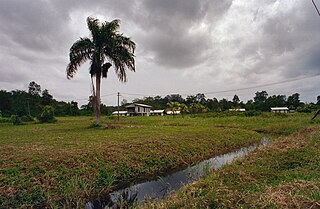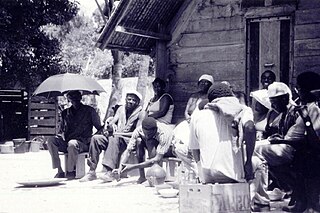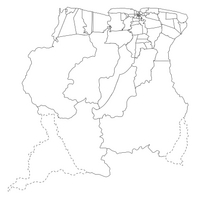
Politics of Suriname take place in a framework of a parliamentary representative democratic assembly-independent republic, whereby the president of Suriname is the head of state and head of government, and of a pluriform multi-party system. Executive power is exercised by the government. The executive power is dependent on the Parliament in theory. Legislative power is vested in both the government and the National Assembly. The judiciary is independent of the executive and the legislature.

Paramaribo is the capital and largest city of Suriname, located on the banks of the Suriname River in the Paramaribo District. Paramaribo has a population of roughly 241,000 people, almost half of Suriname's population. The historic inner city of Paramaribo has been a UNESCO World Heritage Site since 2002.

Commewijne is a district of Suriname, located on the right bank of the Suriname River. Commewijne's capital city is Nieuw Amsterdam. Tamanredjo is another major town, while Meerzorg is the most populated.

Saramacca is a district of Suriname, in the north. Saramacca's capital city is Groningen, with other towns and cities including Batavia, Kampong Baroe, Uitkijk, Maho and Boskamp. Saramacca has a population of 17,480 and an area of 3,636 km2.

Wanica is a district of Suriname located in the north of the country. Wanica's capital city is Lelydorp, the second-largest city in Suriname. Wanica has a population of 118,222 and an area of 443 km2. Following neighbouring Paramaribo, Wanica is the second most populated and urbanised district of Suriname. Two-thirds of the country's population live in these two districts.

Cornelis Lely was a Dutch politician of the Liberal Union (LU) and civil engineer. He oversaw the passage of an act of parliament authorising construction of the Zuiderzee Works, a huge project – designed to his own plans – that turned the Zuiderzee into a lake and made possible the conversion of a vast area of former seabed into dry land.
The Kwinti are a Maroon people, descendants of runaway African slaves, living in the forested interior of Suriname on the bank of the Coppename River, and the eponymous term for their language, which has fewer than 300 speakers. Their language is an English-based creole with Dutch, Portuguese and other influences. It is similar to the languages spoken by the Aluku and Paramaccan Maroons, and split from Sranan Tongo in the middle 18th century. The Kwinti had a population of about 300 in 2014 and adhere to the Moravian Church.

Wanhatti is a village and resort in Suriname, located in the Marowijne district on the Cottica River. The resort is inhabited by the Ndyuka Maroons, and has a population of 468 people as of 2012. The village is primarily inhabited by Ndyuka of the Ansu clan or lo.

Groningen is the capital town of the Saramacca District, Suriname.

The ten districts of Suriname are divided into 63 resorts. Within the capital city of Paramaribo, a resort entails a neighbourhood; in other cases it is more akin to a municipality, consisting of a central place with a few settlements around it. The resorts in the Sipaliwini District are especially large, since the interior of Suriname is sparsely inhabited.

Meerzorg is a town and resort (municipality) in Suriname, located on the eastern bank of the Suriname River, directly opposite the capital Paramaribo. Its population at the 2012 census was 12,405. Since 2000 it has been connected to Paramaribo by the Jules Wijdenbosch Bridge, named after the former President Jules Wijdenbosch.

De Nieuwe Grond is a resort in Suriname, located in the Wanica District. Its population at the 2012 census was 26,161. Its main ethnic groups are East Indian, and Creoles. The resort is named after a sugar plantation in 1770. The plantation was already abandoned in 1863, when slavery was abolished, because that year, it was up for public auction. The area used to consist of small scale agriculture with a focus on vegetables and rice, but due to its proximity to Paramaribo, it has become a suburban area with a young population. In 2019, a new bigger market opened in the town.

Kwatta is a resort in Suriname, located in the Wanica District. Its population at the 2012 census was 14,151.

Saramacca Polder is a resort in Suriname, located in the Wanica District. Its population at the 2012 census was 10,217. And the majority of the population is of East Indian descent. The Saramacca Polder was created between 1894 and 1904. The main function was agriculture. The Commissaris Weytinghweg was built in 1906, and connects the polder with Paramaribo. Initially the area was mainly used for rice cultivation, but has become home to companies and suburban housing.

Santigron is a Maroon village in Lelydorp, Suriname. The village of Santigron is along the Saramacca River not far from Paramaribo. It is one of Suriname's Maroon villages, where descendants of 18th Century run-away slaves live. Unlike in Brazil or Jamaica, some 20,000 Maroons are still living in Suriname 's rainforest and retain many aspects of their traditional Afro-American culture. The village was founded by Jajasie Adoemakeë in the middle of the 19th century. Adoemakeë started working at a nearby wood plantation, and claimed to have received ownership after the plantation owner died in 1861, however the deed was lost.
NAKS is a social and cultural organization which promotes Afro-Surinamese culture and expression in Suriname and worldwide. The organisation was founded in 1948 with Eugène Drenthe as its first president, when it emerged as the successor of association football club T.O.P. which was founded a year prior.

The Matawai are a tribe of Surinamese Maroons. The Matawai were originally part of the Saramaka, and signed a peace agreement with the Dutch colonists in 1762. The tribe split from the Saramaka, and in 1769, they were recognized as a separate tribe.

Regional Hospital Wanica is a hospital in Lelydorp, Suriname. The hospital opened on 7 February 2020 in its initial stage, and serves the Wanica District. With 180 beds and 9 ICU beds, it will be a full-service hospital for the region without the need to go to Paramaribo. Antoine Elias, Minister of Health, reported that the radiology, laboratory, mortuary and emergency aid department were still under construction.
Jaw Jaw, also Yaw Yaw, is a village of Saamaka Maroons in the Boven Suriname resort of the Sipaliwini District of Suriname. The village is located on the Suriname River.




















